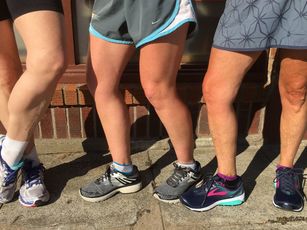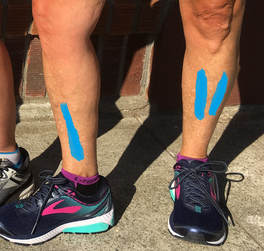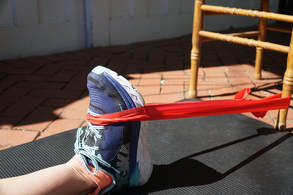 Dreaded pain along the front of the lower leg is a very common issue for runners. Shin Splints, as this is commonly called, occur for a variety of reasons and the pain can run the gamut from mild to debilitating. What are the factors that contribute to shin pain and what can you do to get back to pain-free shins? What are Shin Splints?  Shin splints is a catch all term that refers to pain in your lower legs. Pain can occur usually along the bone on the front of your leg sometimes towards the lower inside or upper outside. The pain can be a mild ache that starts during a run and feels better as you warm up. Or it can be so painful that you cannot run and even feel it when inactive. Shin Splints commonly plague new runners but anyone can have shin splints flare up if they do too much too soon. Too much too soon can mean adding too much volume or intensity or just a sudden change in routine. Shin Splints are an “overuse injury” and can result from pounding over and over again with not enough rest or with other complicating factors which we’ll get into. And overuse injury can mean something very different for you at different times in your life depending on what your run history has been and other factors such as stress and fatigue. A quick check to see if your shins are bothering you? Wrap your hand around your lower leg with the bone under your palm and squeeze. Does it hurt? Run your thumb up and down pushing along the edge of the bone. Does it hurt? You may have low level shin splints and not even realize it. Shin Splints are very common! What's going on in there? There is a lot of debate about what exactly is happening when someone has shin splints. Think about how your foot shifts and accommodates a wide range of surfaces, the wide range of motion your ankle has and how your calf muscles work to propel you forward in running. There are a lot of different forces at play in that small area of your lower leg! So what is the actual mechanism of the injury? There is a lot of debate about the actual cause of shin splints but it is relatively clear that it may be those (in this case, excessive) forces acting upon an outer sheath the bone causing inflammation and swelling which is painful. For some, it may be not only inflammation of the tissue around the tibia but also inflammation of the muscles and tendons surrounding the bone. You may hear the term “medial tibial stress syndrome” as the more technical terminology. Get it checked out! There are instances where the pain you are feeling may not be shin splints. It’s never a bad idea to get checked out by a medical professional but for the following issues, it could be critical.
Treatment for Shin Splints Start with the basics. Rest those shins! Add in non-weight bearing cross training such as swimming, biking and/or the elliptical. We’d recommend trying deep water running but if you do feel your shins with this exercise (or any of the others) don’t add it in. Ice the area a few times a day for up to ten minutes at a time. Try:
Some also find that compression calf sleeves are helpful. These support the area and can help with pain relief. Sleuth Work! Next it’s time to start evaluating what could be contributing to shin splints. An overuse injury such as this one can have a lot of contributing factors. Are your running shoes worn out? Are your running shoes appropriate for your build and gait? Are you wearing appropriate, supportive footwear when you are not running? Any of these issues can contribute to unhappy shins! Seek out a local running store who can evaluate shoe support and appropriate arch support specific to shin issues. And if you’ve been wearing nothing but flip flops, it’s time to find some more supportive shoes for daily wear! Think back to when the shin splints started. Did they start after a period when you were adding a lot more miles, running more hills or trying to add in faster running? Running or playing other sports on a hard surface such as an aerobics type class in a gym or basketball can also bother shins. Or a change up in the surface you normally run can contribute. For instance, if you suddenly start running a lot more on a trail surface or more hills, this is challenging for your lower legs and they will complain! Sometimes fixing simple issues such as these as well as being mindful of keeping training conservative while you heal is all that is needed to solve shin splints. Durable Shins  There is some evidence that weak and/or tight calf muscles and lower leg stabilizing muscles can contribute to shin splints. Check out our prior blog which dealt with strengthening and stretching calves! Some more specific exercises for shin splints involve an exercise band and some patience as you work the small muscles and tendons that control ankle and foot stabilization. For instance, attach an exercise band to something sturdy. Sit facing the band with your legs straight and loop the band over the top of your foot. Make sure your leg is straight and your heel is supported on the ground. Keep your leg and heel still and bring the top of your foot towards your body. Slowly release back to the starting position and repeat. This particular exercise works the front muscles of your lower leg. Contact coach to get the full set of exercises to build strength and mobility in this area! And don’t forget that overall glute and hip strength also contribute to the overall stability of your body. Glutes galore! We can’t not stop talking about glute strength because we know poor glute strength can contribute to a lot of different issues including shin splints. Next Steps There is some research that indicates gait can play a part in shin splints. Overstriding and landing with your foot out ahead of your body puts a lot of force into that area. Some simple cues to think about are “quick feet” to increase cadence. Increasing your cadence will tend to shorten your stride and bring your landing foot more directly under your body. Note that you shouldn’t speed up but continue to keep the same pace.
Think “run tall” with a slight forward lean from the ankles. This again brings your body forward more directly over your foot when you land. People mistakenly tend to “sit back” when running especially as they get tired. Changing your gait is not an easy thing to do and takes patience and the help of someone who can assess your running form. And changing one aspect of your running form can impact other areas so any changes of this nature should be small and cautious. Like many injuries, what will work for you will be different than for others. It can take some sleuthing to figure out what works for you. And it can take patience to develop better flexibility and strength. If you have tried the things above or simply don’t know where to start contact your coach and see if they can help or reach out to your local physical therapist. They often have tricks and tools up their sleeves and can help determine what specifically may have contributed to your injury. Don’t despair! While they can be painful, shin splints will get better and you can get over them and go on to run or do whatever your activity without worry. Keep your mind positive and focused on figuring out where the system broke down and doing the work to get better and you will be back before you know it.
0 Comments
Leave a Reply. |
Categories
All
Archives
|

 RSS Feed
RSS Feed
